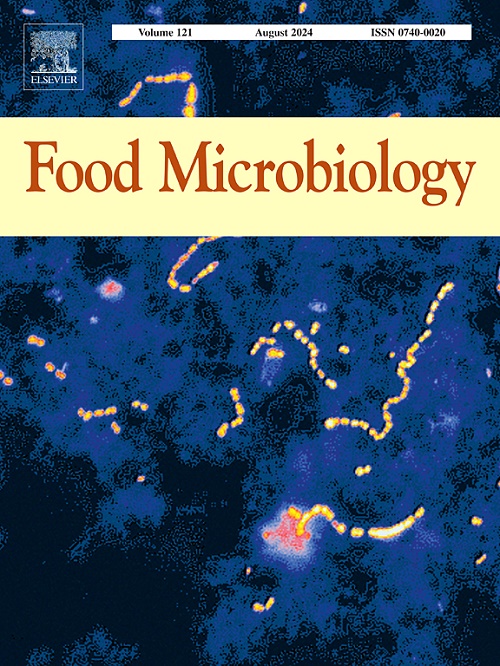Candida species covered from traditional cheeses: Characterization of C. albicans regarding virulence factors, biofilm formation, caseinase activity, antifungal resistance and phylogeny
IF 4.5
1区 农林科学
Q1 BIOTECHNOLOGY & APPLIED MICROBIOLOGY
引用次数: 0
Abstract
This study has provided characterization data (carriage of virulence, antifungal resistance, caseinase activity, biofilm-forming ability and genotyping) of Candida albicans isolates and the occurrence of Candida species in traditional cheeses collected from Kayseri, Türkiye. Phenotypic (E-test, Congo red agar and microtiter plate tests) and molecular tests (identification, virulence factors, biofilm-formation, antifungal susceptibility) were carried out. The phylogenetic relatedness of C. albicans isolates was obtained by constructing the PCA dendrogram from the mass spectra data. Of 102 samples, 13 (12.7%) were found to be contaminated with C. albicans, 15 (14.7%), 10 (9.8%) and five (4.9%) were found to be contaminated with C. krusei, C. lusitane and C. paraplosis, respectively. While seven (16.2%) of 43 Candida spp. isolates were obtained from cheese collected from villages, 36 (83.7%) belonged to cheeses collected from traditional retail stores. The carriage rate of C. albicans isolates belonging to virulence factors HSP90 and PLB1 genes was 30.7%. ALST1, ALST3, BCR, ECE, and HWP (virulence and biofilm-associated) genes were harbored by 30.7%, 23%, 38.4%, 53.8%, and 38.4% of the 13 isolates. According to the microplate test, eight (61.5%) of 13 isolates had strong biofilm production. ERG11 and FKS1 (antifungal resistance genes) were found in 46.1% and 23% of 13 isolates, respectively. Due to missense mutations, K128T, E266D and V488I amino acid changes were detected for some isolates regarding azole resistance. As a result of the E-test, of the 13 isolates, one (7.6%) was resistant to flucytosine, four (30.7%) were resistant to caspofungin, and nine (69.2%) were resistant to fluconazole. The PCA analysis clustered the studied isolates into two major clades. C. albicans isolates of traditional cheese collected from villages were grouped in the same cluster. Among the C. albicans isolates from village cheese, there were those obtained from the same dairy milk at different times. Samples from the same sales points produced at different dairy farms were also contaminated with C. albicans. Concerning food safety standards applied from farm to fork, in order to prevent these pathogenic agents from contaminating cheeses, attention to the hygiene conditions of the sale points, conscious personnel, prevention of cross contamination will greatly reduce public health threats in addition to the application of animal health control, milking hygiene, pasteurization parameters in traditional cheese production.
传统奶酪中的白色念珠菌:白念珠菌在毒力因子、生物膜形成、酪蛋白酶活性、抗真菌抗性和系统发育方面的特征
本研究提供了白念珠菌分离物的特征数据(毒力携带、抗真菌抗性、酪蛋白酶活性、生物膜形成能力和基因分型),以及从土耳其开塞利收集的传统奶酪中念珠菌物种的发生情况。研究人员进行了表型(E-测试、刚果红琼脂和微孔板测试)和分子测试(鉴定、毒力因子、生物膜形成、抗真菌药敏性)。根据质谱数据构建 PCA 树枝图,得出白僵菌分离物的系统发育关系。在 102 个样本中,发现有 13 个(12.7%)受到白僵菌污染,15 个(14.7%)、10 个(9.8%)和 5 个(4.9%)分别受到克鲁赛白僵菌、卢西他白僵菌和副白僵菌污染。在 43 个念珠菌属分离物中,有 7 个(16.2%)来自从乡村收集的奶酪,36 个(83.7%)来自从传统零售店收集的奶酪。属于毒力因子 HSP90 和 PLB1 基因的白念珠菌分离物携带率为 30.7%。13个分离株中分别有30.7%、23%、38.4%、53.8%和38.4%携带ALST1、ALST3、BCR、ECE和HWP(毒力和生物膜相关)基因。根据微孔板测试,13 个分离物中有 8 个(61.5%)具有较强的生物膜生成能力。在 13 个分离株中,分别有 46.1%和 23% 发现了 ERG11 和 FKS1(抗真菌抗性基因)。由于错义突变,在一些分离物中检测到了 K128T、E266D 和 V488I 氨基酸的变化,从而产生了唑类抗药性。E 测试结果显示,13 个分离株中有 1 个(7.6%)对氟尿嘧啶耐药,4 个(30.7%)对卡泊芬净耐药,9 个(69.2%)对氟康唑耐药。PCA 分析将所研究的分离物分为两大支系。从村庄收集的传统奶酪中分离出的白癣菌被归入同一支系。在来自乡村奶酪的白僵菌分离物中,有在不同时间从同一牛奶中获得的分离物。来自不同奶牛场生产的同一销售点的样本也受到白僵菌的污染。关于从农场到餐桌的食品安全标准,为了防止这些病原体污染奶酪,除了在传统奶酪生产中应用动物健康控制、挤奶卫生、巴氏杀菌参数外,关注销售点的卫生条件、有意识的人员、防止交叉污染将大大减少对公共健康的威胁。
本文章由计算机程序翻译,如有差异,请以英文原文为准。
求助全文
约1分钟内获得全文
求助全文
来源期刊

Food microbiology
工程技术-生物工程与应用微生物
CiteScore
11.30
自引率
3.80%
发文量
179
审稿时长
44 days
期刊介绍:
Food Microbiology publishes original research articles, short communications, review papers, letters, news items and book reviews dealing with all aspects of the microbiology of foods. The editors aim to publish manuscripts of the highest quality which are both relevant and applicable to the broad field covered by the journal. Studies must be novel, have a clear connection to food microbiology, and be of general interest to the international community of food microbiologists. The editors make every effort to ensure rapid and fair reviews, resulting in timely publication of accepted manuscripts.
 求助内容:
求助内容: 应助结果提醒方式:
应助结果提醒方式:


